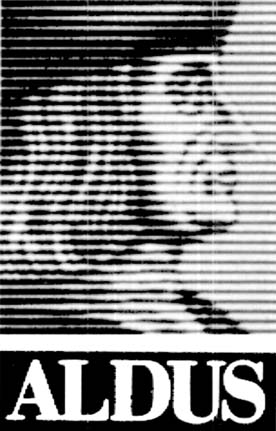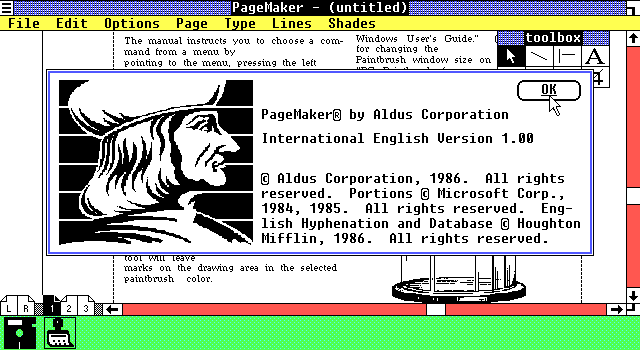 Aldus Corporation
Aldus Corporation
Aldus PageMaker
PageMaker was one of the first desktop publishing programs, introduced in 1985 by Aldus, initially for the Apple Macintosh and, in 1987, for PCs running Windows 1.0. Paul Brainerd was its programmer who saw a niche for a product that could leverage the Apple Macintosh's graphical user interface. When the Aldus Corporation introduced PageMaker 1.0, it revolutionized the publishing industry. Suddenly anyone could design brochures. Publishers had to become computer literate, and Apple started selling Macintoshes and LaserWriters in large numbers.
As an application relying on a graphical user interface, PageMaker helped to popularize the Macintosh platform and the Windows environment. PageMaker relies on Adobe Systems' PostScript page description language.
Aldus Pagemaker 1.0 was released in July 1985 for the Macintosh and in December 1986 for the IBM PC. Aldus Pagemaker 1.2 for Macintosh was released in 1986 and added support for PostScript fonts built into LaserWriter Plus or downloaded to the memory of other output devices. PageMaker was awarded an SPA Excellence in Software Award for Best New Use of a Computer in 1986.
In October 1986, a version of PageMaker was made available for Hewlett-Packard's HP Vectra computers. In 1987, PageMaker was available on Digital Equipment's VAXstation computers. Aldus PageMaker 2 was released in 1987. Until May 1987, the initial Windows release of PageMaker was bundled with a full version of Windows 1.0.3; after that date, a "Windows-runtime" with no task-switching capabilities was included. Thus, users who did not have Windows could run the application from MS-DOS.
Aldus PageMaker 3 for Macintosh was shipped in April 1988. PageMaker 3.0 for the PC was shipped in May 1988 and required Windows 2.0, which was bundled as a run-time version. Version 3.01 was available for OS/2 and took extensive advantage of multithreading for improved user responsiveness.
In November 1989, Aldus PageMaker was released for OS/2 v1.1. Running under Presentation Manager, it cost $795. It required quite a hefty PC at the time with 6 MB of RAM and a 40 MB hard disk. In a first review of the product, it stated that "all of the extravagant claims for the Presentation Manager are suddenly vindicated. Aldus Corp.'s Presentation Manager desktop publishing program doesn't do much that you can't do with the Windows version of PageMaker - it simply does it faster. At virtually every point where Windows users must sit and stare at the hourglass icon, PM [Presentation Manager] users barely have time to blink their eyes before moving on. The difference is so great that those accustomed to the delays in PageMaker for Windows may find themselves waiting for the hourglass to disappear - and then suddenly realize it was never there at all. The PM version allows you to open multiple documents simultaneously and let one document reformat while you work on another. Even in a single document, printing, text importing, and text flow between columns and pages can all proceed in the background while you continue with your work in the foreground. Text loads and flows at about twice the speed of the Windows version."
Aldus PageMaker 4 for Macintosh was released in 1990 and offered new word-processing capabilities, expanded typographic controls, and enhanced features for handling long documents. A version for the PC was available by 1991. Aldus PageMaker 5.0 was released in January 1993.
In 1994, Adobe Systems acquired Aldus and PageMaker.
Adobe PageMaker 6.0 was released in 1995.
Adobe PageMaker 6.5 was released in 1996. Support for versions 4.0, 5.0, 6.0, and 6.5 is no longer offered through the official Adobe support system. Due to Aldus' use of closed, proprietary data formats, this poses substantial problems for users who have works authored in these legacy versions.
Development of PageMaker had flagged in the later years at Aldus and, by 1998, PageMaker had lost almost the entire professional market to the comparatively feature-rich QuarkXPress 3.3, released in 1992, and 4.0, released in 1996. Quark stated its intention to buy out Adobe and to divest the combined company of PageMaker to avoid anti-trust issues. Adobe rebuffed the offer and instead continued to work on a new page layout application code-named "Shuksan" (later "K2"), originally started by Aldus, openly planned and positioned as a "Quark killer". This was released as Adobe InDesign 1.0 in 1999.
While Aldus Corporation was actively maintaining PageMaker, it was also developing another product to compete with QuarkXPress. When Adobe purchased Aldus Corporation the company continued development on this project and released InDesign as a completely separate product.
The last major release of PageMaker was 7.0 on 9th July 2001, after which the product was seen as "languishing on life support". Adobe ceased all development of PageMaker in 2004 and "strongly encouraged" users to migrate to InDesign, initially through special "InDesign PageMaker Edition" and "PageMaker Plug-in" versions, which added PageMaker's data merge, bullet, and numbering features to InDesign, and provided PageMaker-oriented help topics, complimentary Myriad Pro fonts, and templates. From 2005, these features were bundled into InDesign CS2, which was offered at half-price to existing PageMaker customers.
The Macintosh version runs only in Mac OS 9 or earlier; there is no native support for Mac OS X, and it does not run on Intel-based Macs without SheepShaver. It does not run well under Classic, and Adobe recommends that customers use an older Macintosh capable of booting into Mac OS 9. The Windows version supports Windows XP, but according to Adobe, "PageMaker 7.x does not install or run on Windows Vista." The very last minor release was on 30th March 2004, with Version 7.0.2.
